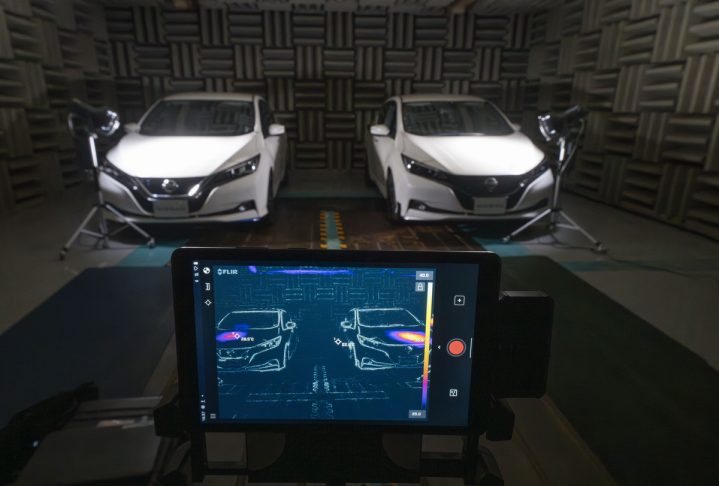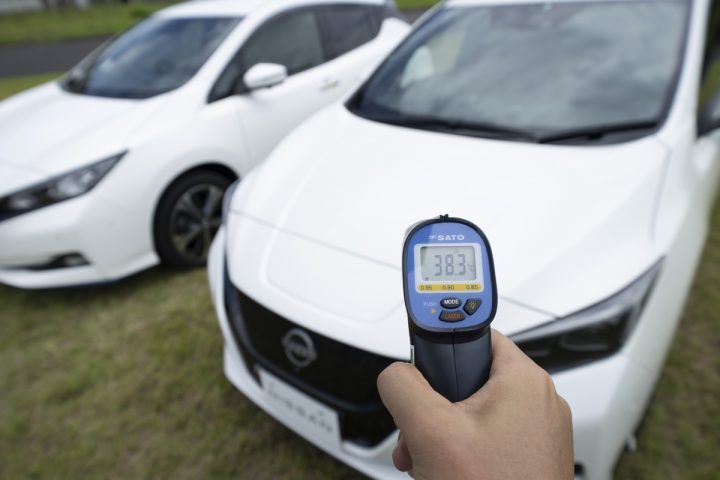
Nissan is pioneering an innovative automotive paint designed to reduce a vehicle’s ambient cabin temperature in summer and decrease the energy usage of air-conditioning systems. This breakthrough, developed in collaboration with Radi-Cool, a leader in radiative cooling products, features metamaterials—synthetic composites with unique properties not typically found in nature.
Related: Strength in numbers – Mitsubishi, Nissan, Honda aligned on strategic partnership
In November 2023, Nissan began a 12-month feasibility trial at Tokyo International Air Terminal at Haneda. Partnering with Japan Airport Terminal Co., Ltd., Radi-Cool Japan, and All Nippon Airways (ANA) airport services, Nissan applied the cool paint to a Nissan NV100 service vehicle operated by ANA.
Haneda airport, with its extensive open tarmac, offers an ideal setting for evaluating the paint’s performance under high-temperature conditions. The results so far have been impressive. Vehicles treated with Nissan’s cool paint have shown a reduction of up to 12 degrees Celsius in exterior surface temperatures and up to 5 degrees Celsius cooler interiors compared to vehicles with traditional paint.

The paint’s cooling effect is especially beneficial when vehicles are parked in the sun for extended periods. A cooler cabin not only enhances comfort but also reduces the air-conditioning run-time needed to achieve a comfortable temperature, leading to improved efficiency in both combustion and electric vehicles.
The metamaterial in Nissan’s cool paint includes two microstructure particles that react to light. One particle reflects near-infrared rays, which typically generate heat in traditional paint. The second particle creates electromagnetic waves that counteract the sun’s rays, redirecting energy away from the vehicle into the atmosphere. Together, these particles significantly reduce heat transfer into the vehicle’s surfaces.
Dr. Susumu Miura, senior manager and expert at the Advanced Materials and Processing Laboratory at Nissan Research Center, leads the development of this paint. Miura, renowned for his work on noise-reducing acoustic materials, has focused much of his career on enhancing vehicle efficiency and comfort.
“My dream is to create cooler cars without consuming energy,” said Miura. “This is especially important in the EV era, where the load from running air-conditioning in summer can have a sizable impact on the state of charge.”
Radiant cooling paint is typically used for buildings and structures, often applied with a paint roller and lacking a clear topcoat, which can leave a chalky residue. Key challenges in developing an automotive version included incorporating a clear topcoat, ensuring spray gun application, and meeting Nissan’s stringent paint quality standards.
Since beginning development in 2021, Miura and his team have tested over 100 samples and are currently evaluating a thickness of 120 microns, about six times thicker than typical automotive paint. They have confirmed the paint’s resistance to salt, chipping, peeling, scratches, chemical reactions, and color consistency. The team continues to explore thinner options that maintain the same cooling performance.
While still in the testing phase, Miura and his team hope that the cool paint will eventually be available for special orders and in various colors. The potential is particularly strong for light commercial vehicles, such as vans, trucks, and ambulances, which spend much of their time on the road.
Watch:


